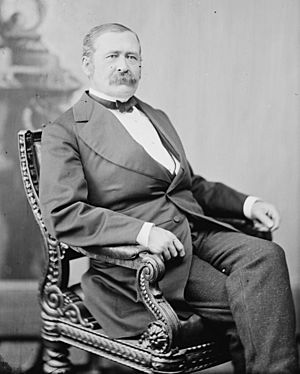John Milton Thayer facts for kids
Quick facts for kids
John M. Thayer
|
|
|---|---|
 |
|
| 6th Governor of Nebraska | |
| In office January 6, 1887 – February 8, 1892 |
|
| Preceded by | James W. Dawes |
| Succeeded by | James E. Boyd |
| 2nd Governor of Wyoming Territory | |
| In office March 1, 1875 – April 10, 1878 |
|
| Preceded by | John Allen Campbell |
| Succeeded by | John Wesley Hoyt |
| United States Senator from Nebraska |
|
| In office March 1, 1867 – March 3, 1871 |
|
| Preceded by | None |
| Succeeded by | Phineas W. Hitchcock |
| Personal details | |
| Born | January 24, 1820 Bellingham, Massachusetts |
| Died | March 19, 1906 (aged 86) Lincoln, Nebraska |
| Resting place | Wyuka Cemetery |
| Political party | Republican |
| Alma mater | Brown University |
| Occupation | Lawyer |
| Signature | |
| Military service | |
| Allegiance | |
| Branch/service | United States Army Union Army |
| Years of service | 1861–1865 |
| Rank | |
| Commands |
|
| Battles/wars | American Civil War |
John Milton Thayer (born January 24, 1820 – died March 19, 1906) was an important American leader. He was a general in the Union Army during the American Civil War. After the war, he became a U.S. Senator for Nebraska. Thayer also served as the Governor of Wyoming Territory and later as the Governor of Nebraska.
Thayer was born in Bellingham, Massachusetts. He went to Brown University and became a lawyer. He also worked as an editor for a magazine. In 1842, he married Mary Torrey Allen, and they had six children.
Contents
Early Life and Moving West
John Thayer grew up in Massachusetts. He learned a lot in school and even taught for a while. After college, he started his own law business. He was also a lieutenant in the local army group called the militia.
In 1854, Thayer and his family moved to the West, settling in Nebraska. He quickly became involved in politics. He joined the Republican Party. He also owned a large farm near Omaha.
Early Public Service in Nebraska
In 1855, Thayer was made a major general in the Nebraska Territorial Militia. This was like being a top military leader for the area. That same year, he met with Pawnee chiefs. He wanted to help calm things down after some raids on settlers. Thayer became known for helping to resolve conflicts with Native American tribes. This led to the Pawnee War of 1859, where he played a key role.
Thayer also helped shape Nebraska's government. In 1860, he was part of a group that created the state's constitution. He was also elected to the Nebraska Territorial Legislature that same year.
Serving in the Civil War
When the American Civil War began, John Thayer wanted to help. He wrote to the Secretary of War, asking to raise a group of soldiers from Nebraska. He left his job in the legislature in June 1861. He became a colonel of the 1st Nebraska Infantry Regiment.
Thayer spent the entire war fighting in the western part of the country. He led a group of soldiers in important battles. These included the Battle of Fort Donelson and the Battle of Shiloh. In 1862, he was promoted to brigadier general. He then led a brigade in the XV Corps.
Key Battles and Commands
General Thayer fought in many more battles. These included the Battle of Chickasaw Bayou and the Battle of Fort Hindman. He also took part in the long siege of Vicksburg. This was a very important victory for the Union Army.
Later, Thayer was put in charge of cavalry (soldiers on horseback). He commanded the District of the Frontier in Arkansas. He was involved in the Camden Expedition. He also saw a lot of action at the Battle of Prairie D'Ane. At the Battle of Jenkins' Ferry, he commanded the soldiers protecting the back of the army. He fought Confederate troops for hours. His actions helped his army escape safely.
In 1865, Thayer was promoted again. He became a major general of volunteers. This was a special honor given at the end of the war.
After the War: A Political Leader
After the Civil War, Thayer continued to serve his country. He helped write Nebraska's state constitution in 1866. When Nebraska became a state, he was chosen as one of its first two U.S. Senators. He served in the Senate from 1867 to 1871.
Governor of Wyoming Territory
In 1875, President Ulysses S. Grant appointed Thayer as the Governor of the Territory of Wyoming. He started this job on March 1, 1875. He worked hard for Wyoming until May 1878. After that, he returned to Nebraska to work as a lawyer again.
Governor of Nebraska
In 1886, Thayer was elected Governor of Nebraska. He served two full terms, from 1886 to 1888. He was the seventh governor of the state.
He also served part of a third term. There was a disagreement about who won the 1890 election. Thayer was governor again for a short time until the election results were officially decided. After this, he retired from public life. He then spent his time on writing and reading.
Legacy and Remembrance
John M. Thayer passed away in Lincoln, Nebraska, on March 19, 1906. He was buried in Wyuka Cemetery in Lincoln.
To honor his contributions, Thayer County, Nebraska, is named after him. There is also a statue of Thayer at the Vicksburg National Military Park in Mississippi. This statue was put there in 1915 to remember his service.

